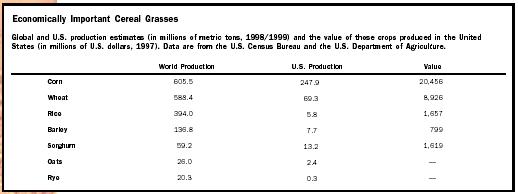Grasses
Grasses belong to one of the largest and most economically and ecologically important families of plants: the Poaceae, formerly called the Gramineae. There are over nine thousand species of grasses recognized by botanists. Grasses can be found on every continent and in a wide variety of habitats, both as the dominant plant type (in prairies and tundra) or as minor components of the plant community. Collectively, grasses domesticated as crops represent the world's most important source of food.
Grasses share a number of characteristics that differentiate them from other plant species. They typically have long, narrow leaves. The stems may be either flattened or round, and they are often hollow. Grasses can grow very tall (tropical bamboos can reach up to 100 meters [328 feet]) or they can grow prostrate along the ground. The root systems of grasses are highly branched (fibrous) and do not have a well-defined central taproot. Many grasses spread horizontally through the production of underground stems known as rhizomes, or prostrate stems aboveground known as stolons. New grass shoots can emerge from either rhizomes or stolons.
Grasses have evolved in environments where drought, grazing by large herbivores, and fires were common. Unlike many plants, the growing points (or meristems) of grasses are located near the base of the plant or below the ground, rather than at the tips of the plant. This characteristic allows grass plants to be grazed or burned without damage to the growing points. Additionally, grasses have large root systems that can store substantial food reserves that allow grasses to regrow quickly if aboveground parts are removed. These features also make grasses drought resistant and ideal for lawns that are repeatedly mowed. The large and fibrous root system of grasses has additional value for preventing soil erosion.
The flowers of grasses are small and inconspicuous. Grass flowers lack petals and other floral parts common in other plant families. Grass flowers are typically wind pollinated and therefore do not produce nectar, but they do produce pollen in large amounts. Grass flowers are so simple and small that they are sometimes referred to individually as florets. Florets are typically grouped or clustered along a central axis into units known as spikelets. The arrangement of florets and spikelets varies greatly among grasses, and individual grass species are often defined by these differences. The fruit of a grass flower is termed a caryopsis or a grain.
Grasses make up many of the most important crop species grown for human consumption. Three cereal crops—corn, wheat, and rice—are the most important source of calories in all diets throughout the world. Sugarcane is a grass that supplies most of the world's sugar. Grasses, including several species of reed and bamboo, are used in many countries as construction material and as thatch for roofs, and the fiber from many grasses is used in making paper. Finally, native and planted grasslands are used worldwide in hay production and as grazing lands for animal production.

| Economically Important Cereal Grasses | |||
| Global and U.S. production estimates (in millions of metric tons, 1998/1999) and the value of those crops produced in the United States (in millions of U.S. dollars, 1997). Data are from the U.S. Census Bureau and the U.S. Department of Agriculture. | |||
| World Production | U.S. Production | Value | |
| Corn | 605.5 | 247.9 | 20,456 |
| Wheat | 588.4 | 69.3 | 8,926 |
| Rice | 394.0 | 5.8 | 1,657 |
| Barley | 136.8 | 7.7 | 799 |
| Sorghum | 59.2 | 13.2 | 1,619 |
| Oats | 26.0 | 2.4 | — |
| Rye | 20.3 | 0.3 | — |
As economically valuable as grasses are, the grass family, like all large plant families, also contains species that are considered pests or weeds and as such incur an economic cost. Crabgrass is a familiar example in lawns, but there are many agricultural weeds that are grasses and these consume resources meant for planted species, interfere with the harvest, and, ultimately, reduce crop yield.
SEE ALSO Agriculture ; Grain ; History of Agriculture ; Monocots
Alan K. Knapp
Bibliography
Chapman, G. P., and W. E. Peat. An Introduction to the Grasses. Melksham, UK: CAB International, Redwood Press, Ltd., 1992.
Heiser, Charles Bixler. Seed to Civilization. Cambridge, MA: Harvard University Press, 1990.
Comment about this article, ask questions, or add new information about this topic: